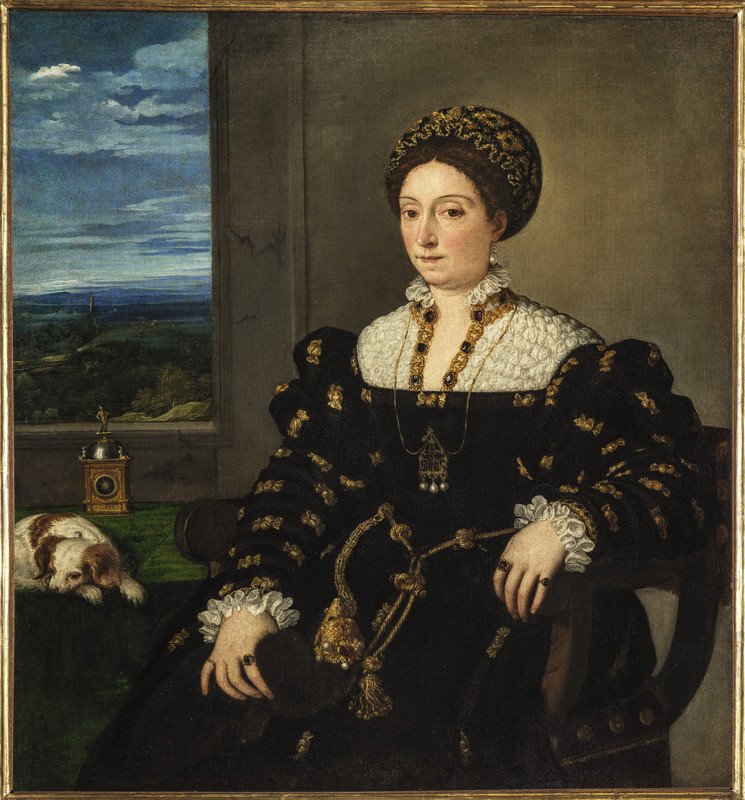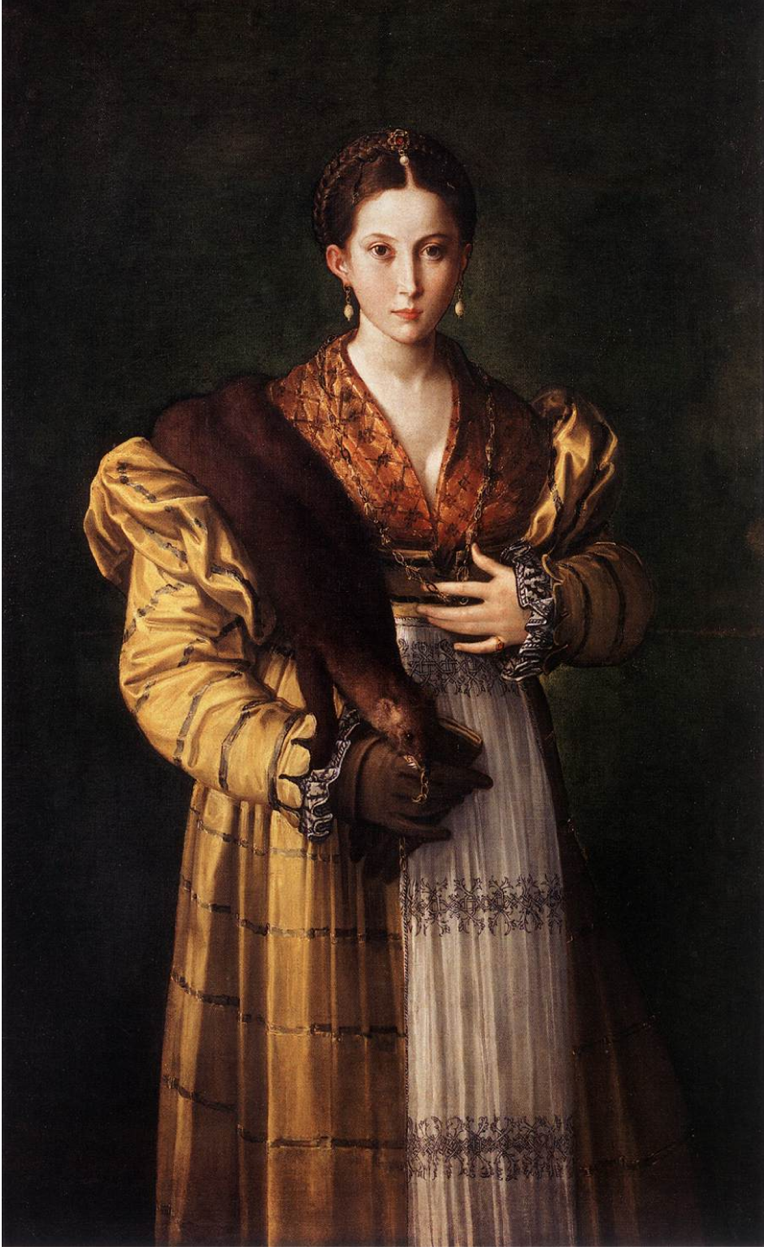Furs
Fig. 1. Isabella’s zibellino. Detail of Titian, ca. 1534-36. Isabella d’Este, Marchesa of Mantua. Oil on canvas, 102.4 x 64.7cm © KHM-Museumsverband.
Keeping in mind that Renaissance portraiture was meant to convey status, wealth, and power, the careful depiction of a fur in Titian’s painting Isabella d’Este, Marquise of Mantua is important. Isabella d’Este (1474-1539), fashion influencer of her time, not only created new styles – such as the zazara worn in the painting – but granted or denied their use to friends and acquaintances in Italy and across Europe as a visible sign of power and political alliances [1].
Completed between 1534 and 1536, the aim of Isabella’s portrait, made when she was in her early sixties, was to highlight her essential role since the first years of her marriage to the marquis of Mantua Francesco II Gonzaga [2]. For that reason, the painting shows the marquise in her youth while her attire is appropriately updated to the fashions of the 1530s [3]. The importance reserved to the accurate depiction of up-to-date garments is evidently a reference to her reputation as fashion trendsetter. Elegantly dressed in a black velvet gown with contrasting deep blue sleeves embroidered in silver and gold, and a pure white chemise peeping out of the low neckline and at the wrists, the fur plays a pivotal role [4]. The soft, long, white hair spotted with black dots indicates that this is the pelt of a lynx, known at the time in Mantua as lovo cerviero (Fig. 1) [5]. Exotic and expensive because it was imported from Russia, the lynx fur – only sporadically mentioned in inventories from the 1450s – became increasing fashionable at the beginning of the sixteenth century when Moscow, after subduing the city of Novgorod (1478), emerged as a leader in the fur trade [6].



This change in fur preferences is corroborated by Isabella’s correspondence with her agents in Venice: if, in a letter dated November 1490 to Giorgio Brognolo, she sought to obtain eighty beautiful sable skins, in March 1511 her desire to come into possession of a lynx fur was disappointed by Taddeo Albano who could not find one [7]. One year later, in February 1512, Taddeo had unwillingly informed the marquise again that his quest in Venice for an entire skin of a beautiful lynx was unsuccessful, and suggested that she try through her contacts in Milan [8]. Isabella was so keen to purchase a lynx fur that a further attempt was made during the last months of the same year, and in January 1513 her request was finally satisfied [9]. Despite the difficulties of procuring lynx skins at the beginning of the sixteenth century, the 1540-42 inventory of the clothes that belonged to her husband – who died in 1519 – includes one lynx-lined overgown, two other linings and three whole pelts [10].
Lynx fur signaled wealth and luxury and thus was a visible marker of rank due to its rarity. As many similar inventories and portraits witness, lynx was mainly used in the sixteenth century for trimming and lining winter overgowns (Fig. 2). At first sight the lynx skin in Titian’s portrait is synonymous with affluence and social status considering that at that time it cost five times as much as sable, a top-quality fur [11]. But what really stands out in the painting is how Isabella wears the lynx pelt: as a luxurious accessory draped over the shoulder and across the chest and probably attached to the belt with a gold chain in her right hand. This fashion, usually with a pelt of a sable or marten, was introduced in northern Italy in the late fifteenth century. As Tawny Sherrill noted, “The familial connection among the sisters Beatrice and Isabella d’Este and their cousin Isabella of Aragon certainly points toward these three women as the originators of this style” [12]. The fur piece, sometimes enriched with a gold head encrusted with precious gems and pearls, became very popular in the following century and is featured in Titian’s Portrait of Eleonora Gonzaga (1537), Duchess of Urbino and Isabella d’Este’s daughter (Figs. 3, 5). Proof of this trend can be found in Cesare Vecellio’s printed costume book De gli habiti antichi, et moderni di diverse parti del mondo (1590) with the illustration of a 1530s Venetian woman donning a sable pelt draped over her shoulders with a gold head attached to a gold chain [13].
Fig. 5. Marten’s head. Venice, ca. 1550-1559. Gold with enamel, rubies, garnets, and pearls. Baltimore, Walters Art Museum.
During the Renaissance, the zibellino – that is, the sable fur accessory – was charged with symbolic meanings related to marital status, fertility and pregnancy, which is the reason why it was frequently among marriage gifts or depicted in bridal portraits (Fig. 4) [14]. Therefore, it seems likely that the aim of Isabella’s portrait depicting an unembellished lynx pelt worn as the zibellino accessory was to allude to her role as a young and prolific wife who, between 1493 and 1507, gave birth seven times to perpetuate the Gonzaga lineage. However, this is the first known depiction of a whole lynx skin sported as a fashion accessory draped over the shoulder and across the chest, so one cannot rule out that Isabella, well-known for her inventiveness in fashion and constantly looking for international products that were difficult to obtain, promoted the style. In the 1530s she introduced an innovative version of the luxury fur piece accessory: she replaced the more conventional and less expensive sable with the highest quality and most coveted pelt of the time, that is, the lynx skin as shown in Titian’s portrait.
Patricia Lurati, NYU Florence
NOTES
[1] ^ For Isabella’s zazara, see Sarah Cockram’s essay for this project here. On Isabella d’Este as a fashion trendsetter, see Sarah Cockram, "Isabella d’Este’s Sartorial Politics," in Sartorial Politics in Early Modern Europe: Fashioning Women, ed. Erin Griffey (Amsterdam: Amsterdam University Press, 2019), 33-56; Christine Shaw, Isabella d’Este: A Renaissance Princess (London: Routledge, 2019), 151-154.
[2] ^ Ibid., 39-59.
[3] ^ On the painting of the young Isabella by Francesco Francia in 1511, derived from the portrait from life by the court painter Lorenzo Costa and provided to Titian as a model, see Silvia Ferino, “Ritratto di Isabella d’Este”, in Tiziano , ed. Susanna Diabene (Venezia: Marsilio, 1990), 218.
[4] ^ For more on Isabella’s chemise, see Sarah Bendall’s essay for this project here .
[5] ^ See note 10.
[6] ^ Piero di Cosimo de’ Medici’s 1456 inventory lists a black velvet dress lined with lynx, see Inventari medicei 1417-1465. Giovanni di Bicci, Cosimo e Lorenzo di Giovanni, Piero di Cosimo , ed. Marco Spallanzani (Firenze: SPES 1996), 104 c. 8v, “Uno ghonellino di vellutato nero foderato di ciervieri”. The 1463 inventory compiled at the death of Sante Bentivoglio, Lord of Bologna includes a pinkish wool overgown lined with lynx fur, see Maria Giuseppina Muzzarelli, Guardaroba medievale. Vesti e società dal XIII al XVI secolo (Bologna: il Mulino 1999), 141. For fur trade see Roberta Orsi Landini, “Zibellini e drappi d’oro: influenze e prodotti di moda fra Italia e Russia”, in Lo stile dello zar. Arte e Moda tra Italia e Russia dal XIV al XVIII secolo, ed. Daniela Degl’Innocenti e Tatiana Lekhovich, (Milano: Skira 2009), 75; Robert Delort, L’histoire de la fourrure de l’antiquité à nos jours (Lausanne: Lazarus 1986), 110, 138; see also Evelyn Welch, “Between Italy and Moscow: Cultural Crossroads and the Culture of Exchange”, in Cultural Exchange in Early Modern Europe. Forging European Identities, 1400-1700, ed. Herman Roodenburg, vol. 4 (Cambridge: Cambridge University Press, 2007), 65-67.
[7] ^ Clifford M. Brown, Isabella d’Este and Lorenzo da Pavia: Documents for the History of Art and Culture in Renaissance Mantua (Geneva: Librairie Droz, 1982), 253 [Busta 2904, Libro 136, c. 65 r-v], “Desiderando nui havere una bella fuodra de zebellini per una albernia, voliamo ne compariati ottanta che siano in tutta excellentia et beleza, se ben dovesti circare tutta Vinetia, et vedere etiam de trovarne uno, da portare in mane, cum l’osso de la testa, como ve habiamo scripto, se ben costasse dece ducati, ché, pur sia bello, non ce agravarà la spesa”. See also Evelyn Welch, Shopping in the Renaissance: Consumer Cultures in Italy 1400-1600 (New Haven and London: Yale University Press 2005), 263 (with an erroneous date of 1496); Isabella d’Este, Selected Letters, ed. and trans. Deanna Shemek (Toronto: Iter Press, 2017), 341, Letter 451: 1511 March 10 Mantua [AG 2996, Libro 29, c. 13r], “Since you were unable to get us the lynx fur sooner, don’t make any effort to send it now because, as you wisely observed, the season is far enough along that we don’t really need it anymore”.
[8] ^ Brown, Isabella d’Este, 253 [Busta 1894], “Del lupo cervero non vedo li sia modo de poter servir la Excellentia Vostra, perché in effetto non ze n’è nessuno de la beleza che quella vorebe, né integro como la richiede (…) Penso che forsi a Milano, sichondo intendo, se ne troverà de più belli et forsi integri como vorebe la Vostra Excellentia”. See also Clifford M. Brown, “Una testa de Platone antica con la punta del naso di cera: Unpublished Negotiations between Isabella d’Este and Niccolò and Giovanni Bellini”, The Art Bulletin, 51, 4 (1969), 375 note 17.
[9] ^ Ibid.
[10] ^ Daniela Ferrari, Le collezioni Gonzaga: L’inventario dei beni del 1540-1542 (Cinisello Balsamo: Silvana, 2003), 324-25, c.140v [6924] “una vesta a l’ongarescha de damascho negro, con una pighetta de veluto nigro, fodrata de lovo cerviero”, [6929] “una fodra de lovo cerviero, de una casacha senza maniche”, [6930] “una fodra de lovo cerviero, de uno salio con le manighe distesse”, [6931] “trei lovi cervieri integri”.
[11] ^ Delort, Histoire de la fourrure, 110.
[12] ^ Tawny Sherrill, “Fleas, Fur, and Fashion: Zibellini as Luxury Accessories of the Renaissance”, Medieval Clothing and Textiles, 2 (2006), 122.
[13] ^ Cesare Vecellio, De gli habiti antichi, et moderni di diverse parti del mondo (Venetia: Damian Zenaro, 1590), 96v-97r. https://gallica.bnf.fr/ark:/12148/btv1b8446755d/f248.item
[14] ^ See Jacqueline Marie Musacchio, “Weasels and pregnancy in Renaissance Italy,” Renaissance Studies 15, 2 (2001), 172-87.







Patricia Lurati